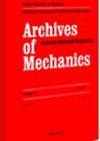Quasi-static and dynamic characterization of ultrafine-grained 2017A-T4 aluminium alloy processed by accumulative roll bonding
IF 1.2
4区 工程技术
Q3 MATERIALS SCIENCE, CHARACTERIZATION & TESTING
引用次数: 0
Abstract
In this study, novel composite strips based on 2017A-T4 aluminium alloy (Al-Cu-Mg) produced by accumulative roll bonding (ARB) were developed. The microstructure and mechanical properties of the ultrafine-grained sheets under quasistatic and dynamic loadings were investigated. The initial microstructure characterization with an Optical Microscope and a Scanning Electron Microscope indicated that the ARBed sheets formed a compact material with the homogeneous and identical thickness for the individual bonded layers. Besides, the presence of precipitates was identified in all the processed strips with diverse sizes, quantities and distribution. Moreover, from Electron Back Scatter Diffraction, the microstructure was noticeably refined with increasing theARBcycles to reach 1.7 µm the grain size at the fifth cycle. The microhardness measurement and the tensile test were carried out for both natural ageing and ARBed specimens. Accordingly, the tensile stress acts on the individual layers rather than the entire sample that conduct to a reduction in the overall properties for the ARBed strips. Furthermore, a stabilization in the mechanical properties for the three first ARB cycles was noted, whereas, the domination of the dynamic recrystallization was responsible for a significant drop after the fourth cycle which is considered as the transition state. The characteristics of the compression deformation were examined under dynamic and quasi-static loadings conditions by using the Split–Hopkinson Pressure Bar system and the universal testing machine, respectively. The strain hardening behaviour was investigated using the Hollomon analysis. It was found that the thermal softening played a crucial role when compared to the strain hardening for all the studied strips. Moreover, the strain rate under the dynamic loading has a minor effect on the stress flow of the ARBed sheets compared to the as-received material.累积辊焊超细晶2017A-T4铝合金的准静态和动态特性
在本研究中,开发了基于累积辊焊(ARB)的2017A-T4铝合金(Al-Cu-Mg)的新型复合带材。研究了准静态和动态加载下超细晶板材的微观组织和力学性能。用光学显微镜和扫描电镜对ARBed片材进行了初步的微观结构表征,结果表明,ARBed片材形成了致密的材料,各粘结层厚度均匀一致。此外,在所有的加工带中都发现了不同大小、数量和分布的沉淀。此外,电子反向散射衍射结果表明,随着arb循环次数的增加,晶粒尺寸明显细化,在第5次循环时达到1.7µm。对自然时效和ARBed试样进行了显微硬度测定和拉伸试验。因此,拉伸应力作用于单个层而不是整个样品,从而导致ARBed带材的整体性能降低。此外,在前三个ARB循环中,力学性能趋于稳定,而在第四个循环(被认为是过渡态)之后,动态再结晶的主导作用导致了力学性能的显著下降。采用Split-Hopkinson压杆系统和万能试验机分别研究了动态和准静态加载条件下的压缩变形特性。采用Hollomon分析研究了其应变硬化行为。结果表明,与应变硬化相比,热软化对所有带材的应变硬化起着至关重要的作用。此外,与接收材料相比,动加载下的应变速率对ARBed板的应力流动影响较小。
本文章由计算机程序翻译,如有差异,请以英文原文为准。
求助全文
约1分钟内获得全文
求助全文
来源期刊

Archives of Mechanics
工程技术-材料科学:表征与测试
CiteScore
1.40
自引率
12.50%
发文量
0
审稿时长
>12 weeks
期刊介绍:
Archives of Mechanics provides a forum for original research on mechanics of solids, fluids and discrete systems, including the development of mathematical methods for solving mechanical problems. The journal encompasses all aspects of the field, with the emphasis placed on:
-mechanics of materials: elasticity, plasticity, time-dependent phenomena, phase transformation, damage, fracture; physical and experimental foundations, micromechanics, thermodynamics, instabilities;
-methods and problems in continuum mechanics: general theory and novel applications, thermomechanics, structural analysis, porous media, contact problems;
-dynamics of material systems;
-fluid flows and interactions with solids.
Papers published in the Archives should contain original contributions dealing with theoretical, experimental, or numerical aspects of mechanical problems listed above.
The journal publishes also current announcements and information about important scientific events of possible interest to its readers, like conferences, congresses, symposia, work-shops, courses, etc.
Occasionally, special issues of the journal may be devoted to publication of all or selected papers presented at international conferences or other scientific meetings. However, all papers intended for such an issue are subjected to the usual reviewing and acceptance procedure.
 求助内容:
求助内容: 应助结果提醒方式:
应助结果提醒方式:


